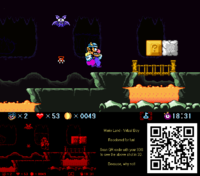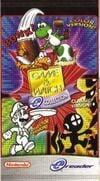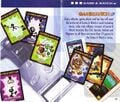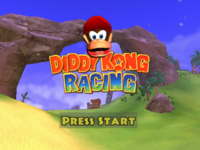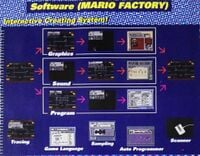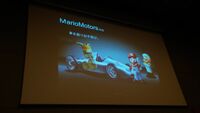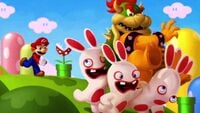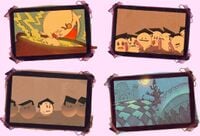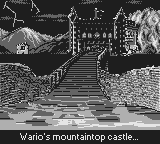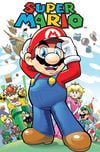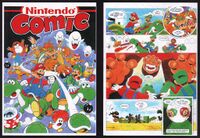List of unreleased media
Template:Distinguish2 Due to various reasons (ranging from being of poor quality, developing a game for a failed or soon-to-be-discontinued system, or the company facing financial or legal woes), a project can end up being canceled and cease production. Despite their status, concepts present in canceled games and other media can be reused in commercial releases, and some canceled games are repurposed into different projects.
A game in development can also end up becoming vaporware, a term for projects that are announced and for which development is started, but for similar reasons, were never published.
The following is a list of Mario media that has been canceled, or was never produced or released.
Canceled games and vaporware
| System | Game | Reason/Description |
|---|---|---|
| Nintendo Entertainment System | Return of Donkey Kong | A follow-up to Donkey Kong, canceled for unknown reasons. |
| Donkey Kong no Ongaku Asobi | A music-based spin-off of Donkey Kong, canceled mainly due to copyright issues with the featured songs. | |
| Philips CD-i | Mario Takes America | Canceled due to financial issues caused by Philips being unsatisfied by the development's progress. Attempts to rework the title into a Sonic the Hedgehog game and even later with original characters fell through, and developer Cigam went bankrupt in 1994.[1] |
| Super Mario's Wacky Worlds | A successor to Super Mario World, canceled due to the discontinuation of the CD-i for its drop-in popularity, as well as development requiring a higher budget.[2] Three official prototype discs are in circulation. | |
| Virtual Boy | VB Mario Land | A sequel to Super Mario Land 2: 6 Golden Coins, otherwise known as Mario Adventure; scrapped in favor of expanding the Mario Bros.-esque mini-game and releasing it as Mario Clash.[3] |
| Unknown platform | Yoshi Racing | A 3D platformer starring Yoshi that was pitched by Argonaut Games to Nintendo but was rejected. Argonaut reworked the game into Croc: Legend of the Gobbos, released for PlayStation, Sega Saturn, Windows, and Game Boy Color. Super Mario 64 allegedly resembles its original design. |
| Nintendo 64DD | Mario Artist series | Of the Mario Artist series, only Paint Studio, Talent Studio, Communication Kit and Polygon Studio were released; Game Maker, Graphical Message Maker, Sound Maker (originally part of Paint Studio) and Video Jockey Maker were canceled, likely due to the 64DD's late release and commercial failure. A different iteration of Paint Studio was in development by Software Creations, but it was canceled due to internal politics between Nintendo of America and Nintendo's headquarters in Japan over control of the project.[4] Additionally, Paint Studio (Japanese version) was originally going to feature a Gnat Attack game mode, but it was later removed, likely due to it negatively affecting the mouse settings for the main painting mode. |
| Super Mario 64 2 | A sequel to Super Mario 64, abandoned due to a lack of progress and the 64DD's late release and commercial failure. Certain aspects were carried over to Super Mario Sunshine and Super Mario 64 DS. May be related to Super Mario 64 Disk Version, a similarly-unreleased working port of the previous game demoed at Nintendo Space World 1996.[5] | |
| Ultra Donkey Kong | At one point, the Nintendo 64 game Donkey Kong 64 was planned as a Nintendo 64DD exclusive.[6] | |
| Super Mario RPG 2 | A sequel to Super Mario RPG: Legend of the Seven Stars, otherwise known as Mario RPG 2[7] and Mario RPG 64[8] while in development. Due to complications involving Square, it was reworked into Paper Mario and was released as a standard Nintendo 64 title. | |
| Game Boy Advance | Diddy Kong Pilot | A follow-up to Diddy Kong Racing, featuring planes as the only vehicle. The first iteration was shown at E3 2001, but was not published by the time Rare was bought by Microsoft in 2002. The second iteration in 2003 was reworked into Banjo-Pilot and released for the Game Boy Advance.[9] |
| Donkey Kong Coconut Crackers | A puzzle game starring Donkey Kong that was unfinished before Microsoft purchased Rare. It was reworked into It's Mr. Pants, also released for Game Boy Advance.[10] | |
| Donkey Kong Plus | A remake of the Game Boy Donkey Kong shown at E3 2002 as a proof-of-concept for connectivity between Game Boy Advance and Nintendo GameCube systems; its intended system is unclear, however. Presumably canceled in favor of or otherwise became Mario vs. Donkey Kong, an original game based on the classic Donkey Kong gameplay.[11] | |
| Nintendo GameCube | ||
| Donkey Kong Racing | Another follow-up to Diddy Kong Racing that was unfinished before Rare was bought by Microsoft. After its cancelation in favor of Star Fox Adventures, it was reworked into Sabreman Stampede for the Xbox 360; unlike the aforementioned games, however, this iteration of the title was unofficially canceled.[12] | |
| Yoshi Touch & Go | Was later reworked into a Nintendo DS title with the same name. | |
| DK Bongo Blast | A Donkey Kong racing game that would have used the DK Bongos. Was reworked for the Wii as Donkey Kong Barrel Blast, replacing the bongo controls with motion controls.[13] | |
| Super Paper Mario | At one point, the game was considered for release on both the Nintendo GameCube and Wii,[14] but it was ultimately pushed to the Wii exclusively.[15] | |
| Wii | Super Mario Spikers | A volleyball-wrestling hybrid game that was being developed by Next Level Games, canceled in favor of Punch-Out!! due to aspects of the game clashing with Nintendo's code of honor.[16] |
Unreleased ports
Template:More images These games were planned ports of already existing Mario titles to different consoles, which went unreleased for various reasons.
3DS version of Virtual Boy Wario Land
On December 15, 2013, independent developer Jools Watsham of Renegade Kid posted a mockup of a colorized version of Virtual Boy Wario Land for the Nintendo 3DS.[17] In a 2016 episode of IGN's NYC podcast, Watsham revealed that he had made a formal pitch to Nintendo to make colorized versions of Virtual Boy Wario Land and Nintendo's other Virtual Boy games for the 3DS, but the pitch was rejected for unknown reasons.[18] He speculated this was because Nintendo did not want to remind people of the Virtual Boy.
Donkey Kong Arcade1UP products
In 2018, a picture from the factory that produces Arcade1UP machines was leaked. This picture showed many previously unannounced models, one of which was Donkey Kong. This was likely a mock-up machine pitched to Nintendo, which ended up being rejected.[19]
At CES 2020, Arcade1UP demonstrated a miniature ColecoVision console, featuring a small "television set" as its screen. The console showed Donkey Kong running on its screen; oddly, it appeared to be playing the Famicom/NES version rather than the real ColecoVision port.[20] The console was never released, and is unclear if the product was ever officially approved; as many products at the booth were labeled as "pending licensor approval".
Donkey Kong for TRS-80
In 1982, a port of Donkey Kong for the TRS-80 line of microcomputers was being developed by game designers Wayne Westmoreland and Terry Gilman. The port was eventually finished, but never received an official release as the duo could not get permission from Nintendo.
Later, in 1995, Westmoreland released all of their TRS-80 titles to the public domain, including the unreleased port of Donkey Kong.[21]
Donkey Kong 3 for Mini Classics
A planned Mini Classics version of Donkey Kong 3 was in the works, but never got released. In a stock image, it is mislabeled as Donkey Kong Junior.[22]
Donkey Kong 3: Dai Gyakushū for FM-7
An unknown video game company pitched an idea to Nintendo to port Donkey Kong 3: Dai Gyakushū to the FM-7. They purchased the rights and produced it, but it went unreleased.[23]
Donkey Kong Jr. Coleco Tabletop (early version)
The tabletop arcade version of Donkey Kong Jr. by Coleco, released in 1983, was a rebranded version of the Game & Watch Tabletop version. However, early promotional images show a machine more in line with Coleco's other tabletops, with a completely different port than the released model (which looks closer to the original arcade game).[24] A mock-up machine has been found, but it contained the original Donkey Kong inside.[25] [dead link]
Donkey Kong Jr. for BBC Micro
A port of Donkey Kong Jr. for BBC Micro by Atarisoft, who also developed the Atari 8-bit port, was created but ultimately unreleased.[26]
Enhanced Donkey Kong and Donkey Kong Jr. ColecoVision ports
In the early 2000s, incomplete prototype versions of Donkey Kong and Donkey Kong Jr. for ColecoVision were discovered. Both cartridges actually postdated the ColecoVision releases and were seemingly ports of the versions from the Coleco Adam computer, which featured more levels and cutscenes. The games were re-compiled into hacked ROMs titled "Super DK!" and "Super DK Junior" respectively; the unaltered ROMs were never released.[27][28]
Famicom Mini Collection
- Main article: Classic NES Series § Famicom Mini Collection
A multicart of Famicom/NES games ported to the Game Boy Advance, planned to be released in China by iQue. It featured Mario Bros., Super Mario Bros., Wrecking Crew, Dr. Mario, Donkey Kong, and Super Mario Bros. 2 (Japan), in addition to Clu Clu Land, Ballon Fight [sic], Metroid, Excite Bike, and Ice Climber.
Game & Watch-e
As early as the North American launch of the e-Reader, Nintendo had unveiled plans to release a series of Game & Watch cards for the e-Reader device. However, the only card ever released was a promotional card for Manhole (bundled in with the e-Reader itself), with the full set never being produced. The card packs, officially titled Game & Watch-e or Game & Watch-e Collection, were to feature three versions of games: classic, color, and collector. The classic versions were the original games, while the color versions were similar to the "Modern" modes in the Game & Watch Gallery series (featuring the Mario characters). The exact details of the collector versions remain unknown, though the card packaging artwork showcases it with a black-and-white Luigi.
The game ports appear to be unique from Game & Watch Gallery 4; a few advertisements show a screenshot of the color version of Fire, which has a more basic background (e.g. the grass and sky) compared to the Modern Gallery 4 version. Additionally, a few advertised games did not receive other Game Boy Advance ports at all; namely, Spitball Sparky and the color version of Vermin (featuring Yoshi).[29]
In an August 2003 brochure from Walmart, it was stated that the cards were planned to launch in October of that year. The short release window implies that the Game & Watch-e line was effectively completed before it was abruptly canceled.[29] Its cancelation was most likely due to the failure of the e-Reader on the North American market, though no official reasoning is known.
Mario Bros. Apple II port
Mario Bros. was ported to the Apple II in 1984 by Atari, but was never officially released. Despite this, its code was leaked (possibly by an actual Atari employee) and was widely distributed in the 1980s via piracy.[30] There was even a bootleg Russian arcade version of Mario Bros. based on the Apple II prototype known as Kuzmich-Egorych (Кузьмич-Егорыч).[31]
Mario Bros. Atari 8-bit port (1984 version)
In 1984, Atari planned to release Mario Bros. for their Atari 8-bit computer line (400/800/XL/XE). This port was identical to the previously released Atari 5200 version of the game. For unknown reasons, the game was canceled despite being fully finished. Mario Bros. would eventually receive an Atari 8-bit release in 1988, but this port was completely different than the 1984 prototype.[32]
Mario Bros. Commodore 64 port (1984 version)
Yet another Mario Bros. port that went unreleased was the Commodore 64 version, once again planned for a 1984 release. This version was to have been published by Atari, but was developed by two programmers from Designer Software.[33][34] A completely different (and rather bizarre) port for the Commodore 64 would later be released by Ocean in 1987.[35]
Mario Kart Wii for Nvidia Shield
Mario Kart Wii was one among several Wii games that were ported on the Nvidia Shield in China. Announced during ChinaJoy 2018,[36] the port was playable at the event, with a competition being held in the game's Time Trial mode.[37] It would have featured online multiplayer, which is no longer available on the original game due to the discontinuation of the Nintendo Wi-Fi Connection.[38] It is the only Wii game on the Nvidia Shield that was never released despite being fully finished, as the developers did not receive any final answer from the Chinese government during the approval process.[39] All Wii game ports on the Nvidia Shield were later delisted in 2021 and made unplayable in 2022, with the verification server shutting down due to the system's discontinuation in China.[40][41][42]
Mario Party and Mario Party 2 for 64DD
The first two Mario Party games were among many announced titles for the Nintendo 64DD,[citation needed] but the peripheral was a commercial failure. This resulted in all Mario games for the system being canceled, except for four Mario Artist games.
Other Atarisoft computer ports
In several magazine publications, an advertisement from Atari was run stating that Mario Bros. and Donkey Kong Jr. would release for the Commodore 64, IBM PC (DOS), and Apple II. None of these ports were ever released, but as aforementioned, the Apple II and Commodore 64 versions of Mario Bros. have been found. The flyer also lists several never-released ports of Crystal Castles, Typo Attack, and Track & Field.[43]
According to The Atarisoft FAQ, the following ports were also planned:
- Donkey Kong for the BBC Micro and IBM PCjr.
- Donkey Kong Jr. for the Commodore VIC-20 and ZX Spectrum
- Mario Bros. for the Commodore VIC-20
Several of these have also been confirmed by other sources.[44][45]
Super Game Module Donkey Kong games
The Super Game Module was a canceled peripheral for the ColecoVision, which took unique cartridges. Among its planned games were Super Donkey Kong and Super Donkey Kong Junior; these may be related to the "enhanced" Donkey Kong and Donkey Kong Jr. ColecoVision ports seen above.[46]
Super Mario 64: Disk Ban
Super Mario 64: Disk Ban (スーパーマリオ64 ディスク版, lit. "Super Mario 64: Disk Version"), known as Super Mario Disk Version in the title screen, is a port of Super Mario 64 for the Nintendo 64DD that was only officially shown publicly at Nintendo's Shoshinkai 1996 trade show to showcase the system's performance.[47] It was dumped in 2014.[48] The main differences in the port compared to the original game are a title screen replacing Mario's face, an updated sound engine, and longer loading times. The port also contains a bug where the game crashes when entering Wiggler's Basement in Tiny-Huge Island.[49]
Super Mario Bros. Firebird pitch
In the 80s, a company called Firebird pitched an idea to Nintendo to port Super Mario Bros. to the Commodore 64 and got the rights, but production never got finished.[50][dead link]
Super Mario Bros. Orpheus Software pitch
In 1986, small subsidiary developer Orpheus Software planned a short, one-level demo of Super Mario Bros. for the Commodore 64 and attempted to pitch it to Nintendo for an official release, with Nintendo later rejecting the project[51]. A Lemon64 thread from 2005 claims that user NYCeguy24 may have owned a copy, but this is likely speculation[52].
Super Mario Bros. 3 id Software pitch
In 1990, in its infancy, video game company id Software developed a demo for the IBM PC titled Dangerous Dave in Copyright Infringement, which was a recreation of the first level of Super Mario Bros. 3.[53] It was then decided to rework the demo into an actual port of Super Mario Bros. 3 for PC; the game was then pitched to Nintendo, which they ended up rejecting. The Super Mario Bros. 3 demo was later extensively modified and turned into Commander Keen in Invasion of the Vorticons, which was released on December 14, 1990.[54][55]
In July 2021, a copy of the id Software pitch was donated to the Strong National Museum of Play, and is currently held in the museum's archives.[56]
Wario Land for NES
In the November 1993 Nintendo Power "Official Game Pak Directory", Wario Land is listed as an upcoming NES game (while also being listed for Game Boy); this may have been done in error, however.[57]
Yoshi's Cookie on Wii U Virtual Console
Yoshi's Cookie was originally slated for release on the Wii U Virtual Console, but was ultimately never released.[58] Its cancellation was likely due to a copyright issue (either with Biox or Bullet-Proof Software), which is further evidenced by the Wii Virtual Console version being delisted from the Wii Shop Channel around the same time.
Low-information media and rejected pitches
This section lists rejected pitches (meaning ideas proposed internally or to Nintendo without seriously going into production) and canceled projects, most of which have too little information to warrant their own pages.
Games
Boss Game Studios' Mario game pitch
Sometime during the late '90s, Boss Game Studios pitched a Mario game to Nintendo of America. The only known proof of its existence is a storyboard, drawn by Patrick Michael Clark, bought in an online auction showing Mario stepping on a wooden plank, following by the wooden plank sprouting legs and walking in Mario's direction. According to a Boss Game Studios employee, "The Mario thing I think was for a proposal. I’m not sure if we were trying to get the license from Nintendo to produce a Mario game, or if they approached us to do one. Either way, I think it died on the vine after they saw the concept art"[59]
CD-i Donkey Kong game
A Donkey Kong game was in development for the Philips CD-i. The only known report of it is the LinkedIn resume of programmer Adrian Jackson-Jones, which states the game was in development during the 1992-1993 period at RSP. Jackson-Jones "designed and implemented the game engine" for the project[60]. Jackson claims he worked on the game alongside programmer Owen Flatley and that he has no surviving assets left of the game.
DDR MARIO 2
According to a leaked internal Nintendo spreadsheet, a game labeled as DDR MARIO 2 - presumably an abbreviation for Dance Dance Revolution Mario 2 - was planned to be released on the Wii. The game was to be developed by Konami. However, the document mentions that development had not started yet; it may have never gotten past the concept stages.[61]
Diddy Kong Racing Adventure
- Main article: Diddy Kong Racing Adventure
Diddy Kong Racing Adventure was a pitched sequel to Diddy Kong Racing being developed by Climax. It was never announced to the public in any capacity and only became known after an amateur video game archivist acquired the prototype and published a video about it in November 2016.[62]
Donkey Kong IV
Donkey Kong IV is a rumored final title in the original Donkey Kong series. The game is stated to have only been test-marketed in arcades, never getting a full release. It was only ever reported in issue #13 of Mean Machines magazine (October 1991), and was possibly the result of a misconception or confusion for another game (a likely candidate being Ocean's Kong Strikes Back!).[63]
Donkey Kong Country 4
According to Rare employee Paul Rahme, it was internally suggested at Rare to make a new Donkey Kong Country game for the Nintendo DS, as remaking the trilogy for the Game Boy Advance gave the developers experience and a good basis for making a sequel. The pitch ended up not getting much traction internally and was dropped.[64][65]
Donkey Kong parking attendant arcade game
In 1983, before creating the game show Catchphrase and producing Hotel Mario, entertainment producer Steve Radosh was involved in developing an arcade game starring Donkey Kong as a parking attendant for Sega, as the company had rights to the property at the time.[66] The game was canceled when Gulf and Western Industries, the American conglomerate which at the time was Paramount Pictures' corporate parent, sold its ownership of Sega's U.S. assets to pinball machine maker Bally Manufacturing.
Mario American football game
During the early years of Retro Studios, plans were underway for an American football game featuring Mario for the GameCube. At the request of Nintendo, the project was reworked early on to turn it into a generic, realistic football game (known as both NFL Retro Football and Retro Studios Football). Its Mario-less incarnation was ultimately canceled as well, reportedly due to Retro Studios focusing all development on 2002's Metroid Prime.[67]
Mario Factory
In 1994, a Nintendo patent was created for a device that could create basic games for the SNES, likely intended for use in schools.[68] The program for creating said games was titled Mario Factory, and featured loose adaptions of the Mario characters.[69] It is known that the patented machine itself had been released in Japan at some point, being used with the "Game Processor RAM Cassette".[70] It is possible that Mario Factory was actually completed and used for this machine, but nothing has ever proved this, and it may have been a non-Mario-branded software in the final product. This is unrelated to the Mario Factory arcade center in Japan.
Mario Motors
Mario Motors was a pitch made by game designer Yoot Saito for a Nintendo DS game. The game had players "shaving and sculpting out of a chunk of metal to make a cylinder [which then] decides the ability of your engines.". Saito also considered having the player blow in the DS's microphone to "learn how acceleration works" but scrapped it because the mechanic could have been too demanding for children. Despite initial interest from both Satoru Iwata and Shigeru Miyamoto, the project never got off the ground with Saito stating, "I can’t tell you why, but please guess."[71]
Mario Paint 3D
Mario Paint 3D was an unreleased Mario Paint game planned to be released for the Nintendo 64. According to Shigeru Miyamoto, Mario's head on the title screen of Super Mario 64 actually originated from a prototype of this game.[72]
Mario/Rabbids crossover adventure game
In 2010, Ubisoft Paris had explored proposing a crossover between the Mario franchise and its own Rabbids franchise.[73] The game was conceptualized as a "subversive, self-aware take" on the Mario franchise and concept art was produced depicting Rabbids kidnapping Bowser as Mario chased them. According to an anonymous Ubisoft employee, the pitch was possibly rejected by Nintendo before it was formally shown. According to Ubisoft employee Davide Soliani, this attempt is unrelated to Mario + Rabbids Kingdom Battle.[74]
Mario's Castle
Mario's Castle was a game announced for the canceled "Project Atlantis" portable system. The only known report of it was in an issue of the gaming magazine Electronic Gaming Monthly[75].
Mario's Mission Earth
Mario's Mission Earth, also known as Mario's Planet Quest,[76] was a canceled SNES edutainment game from The Software Toolworks, which would have likely been similar to Mario is Missing! and Mario's Time Machine. The only evidence of the game's existence is a brief mention on composer Mark Knight (who also worked on the SNES port of Mario's Time Machine) list of works on his personal webpage[77], which was later reiterated on a post for a 2017 Kickstarter campaign.[78] It is unclear how far the game got into development.
Retro Studios' Boo project
Former Retro Studios artist Sammy Hall revealed that a “cancelled Boo project” was in pre-production from 2006 to 2007. One sketch titled “tiny stuff for tiny handheld resolutions” suggests that it was a Nintendo DS title. The Boo art also includes sketches titled “possession powers” depicting a capture-like gameplay mechanic and new witch creatures called “Broomies”, alongside a potential world map. One sketch titled “Deep in debt at Haunt University” seems to depict a storyline involving a professor version of King Boo. The “Haunt” post containing the Boo project artwork, along with Sammy Hall's posts for a “cancelled Zelda project” starring Sheik, was taken down from ArtStation on May 7, 2020.[79] Sammy Hill later clarified that the cancellation of both projects was due to ex-leads Mark Pacini, Todd Keller and Kynan Pearson leaving Retro Studios.[80]
Super Donkey
In July 2020, a large amount of Nintendo-related source code and prototypes were leaked and released to the public. Among this leak was the source code to Super Mario World 2: Yoshi's Island, which included many prototypes that were greatly different from the final product. However, two files are so early that they have virtually no connection to the game at all - "super_donkey_1" and "super_donkey_2". These games presumably served as the basis of what became Yoshi's Island, though most elements of Super Donkey were eventually scrapped.[81] Among the recognizable elements are Melon Bugs, apes that may be an early version of Grinders, and a dog enemy that may have been the inspiration for Poochy.[82]
At first glance, the game itself features a generic protagonist and no connection to Mario. However, various graphic scratchpads (scattered across other files) confirm that at some point, the game starred Mario, with Donkey Kong appearing as well. This strongly implies that the game was originally a Donkey Kong title, which was never formally announced or shown to the public.
Tesla Mario Kart game
According to Elon Musk, a Mario Kart game that would be played on Tesla vehicles was proposed to Nintendo. Nintendo did not give them a license.[83]
VB Mario Kart
The German magazine Big N claimed that a Virtual Boy installment of the Mario Kart series, tentatively named VB Mario Kart, was in development[84]. The only known media report of it is Big N's August 2000 issue, which listed it among various other canceled Virtual Boy projects.
Wario Pool
In 2001, a Game Boy Color billiards game titled Wario Pool was pitched to Nintendo by veteran game developers Nick Pelling and Jeff Ferguson. The pitch was ultimately rejected, and the game was modified and released as 3D Pocket Pool instead.[85] Nick Pelling later posted the mock-up intro to the game on his website.
Film
Film adaptation of Super Paper Mario
Director Seth Gordon planned to release a film adaptation of Super Paper Mario, but has not had the opportunity to talk to Nintendo about it.[86]
Sony Pictures Mario film
Internal emails leaked to the public by proxy of the 2014 Sony Pictures hack detailed negotiations between Avi Arad and Nintendo to have Sony Pictures produce a Mario movie. The email exchange between Avi Arad and Sony Pictures executive Amy Pascal showed photos of Arad meeting with Shigeru Miyamoto and Satoru Iwata; Pascal would later forward one of the emails to another executive with the comment "Avi closed Mario brothers" (Arad would later state to the press the deal had in fact not been closed after the emails were made public by the hack)[87]. Although no information beyond what is found in the leaked emails was made public, it seems the talks broke down as Nintendo would officially announce in 2018 that a Mario film would be produced by Illumination, an animation company owned by Sony Pictures' rival Universal Pictures best known for the Despicable Me franchise.
Print media
Archie Comics Mario comic pitch
- Main article: Archie Comics Mario comic
Comic book publisher Archie Comics (which has published other comics based on famous video game properties including Sonic the Hedgehog and Mega Man) pitched a Super Mario comic book series to Nintendo, but it was rejected, as confirmed by writer Ian Flynn.[88][89] The concept art for the pitch was drawn by Archie artists Tracy Yardley and Ben Bates.
Fleetway Mario comic pitch
In the mid-90's[90], Nintendo, seeing the success of Fleetway Publications's Sonic The Comic, approached the company with an offer to make a similar title based on Nintendo characters. To this end, artist Richard Elson and writer Nigel Kitching produced a mock-up, featuring a cover and a short story showing Mario and Luigi arriving in the Mushroom Kingdom, fighting Koopalings and Boos, coming to face with a monstrous Donkey Kong Jr., and finally escaping in a Warp Pipe. Nintendo ultimately passed over the idea after taking multiple years to make a decision[90].
Reflecting on the comic, an unnamed source explained that Nintendo was a more "regulated" and "hands-on" company than Sega and that having to wait for approval for a regular publication such as a comic would have been a "nightmare"[90]. Though the pitch was rejected, Fleetway would ultimately produce a comic for Nintendo, the Donkey Kong Jungle Action Special.
Miscellaneous
Super Mario Bros. Christmas Show
Among the trademarks present in the document "Action man & 67 other titles; musical compositions." filed by DIC Entertainment and EMI Music Publishing is one for the Super Mario Bros. Christmas Show.[91] Additionally, the document "SMC 60 second theme; musical compositions." filed by Andy Heyward and his wife contains a trademark for the Super Maria[sic] Bros. Christmas Show.[92]
Mario's World Toy Set
References
- ^ Monokoma. (September 15, 2014). Mario Takes America [CDI – Canceled]. Unseen64. Retrieved May 18, 2015.
- ^ Super Mario's Wacky Worlds
- ^ Official Nintendo Magazine UK, January 2010[dead link]
- ^ Monokoma. (April 4 2008). Creator / Mario Artist [64DD – Beta / Canceled]. Unseen64. Retrieved May 18, 2015.
- ^ Photos of Super Mario 64 disk version, GameKult[dead link]
- ^ http://www.ign.com/articles/1997/07/26/donkey-kong-swings-to-64dd
- ^ Miyamoto Reveals Secrets: Fire Emblem, Mario Paint 64. (July 29, 1997). IGN. Retrieved May 18, 2015.
- ^ Iwata Asks: Paper Mario: Sticker Star: "Going All Out with Stickers"
- ^ Diddy Kong Pilot [GBA – Beta / Canceled]. (April 7, 2008). Unseen64. Retrieved May 18, 2015.
- ^ Donkey Kong Coconut Crackers [GBA – Canceled] (It’s Mr. Pants [GBA – Beta]). (April 7, 2008). Unseen64. Retrieved May 18, 2015.
- ^ Donkey Kong Plus [GBA – Canceled]. (April 8, 2008). Unseen64. Retrieved May 18, 2015.
- ^ Donkey Kong Racing [GameCube – Canceled]. (April 8, 2008). Unseen64. Retrieved May 18, 2015.
- ^ Donkey Kong Bongo Blast [GC – Unreleased]. (April 9, 2008). Unseen64. Retrieved May 18, 2015.
- ^ Wii Preview: Super Paper Mario. NGamer Magazine (January 5, 2007). Retrieved July 17, 2016.
- ^ Super Paper Mario [GC – Canceled]. (April 9, 2008). Unseen64. Retrieved May 18, 2015.
- ^ Tamaki. (August 6, 2011). Super Mario Spikers [Wii – Canceled]. Unseen64. Retrieved May 18, 2015.
- ^ https://twitter.com/JoolsWatsham/status/412463614302240769
- ^ IGN (April 02, 2016). Mutant Mudds' Developer Made a Wario Demo - NVC. YouTube. Retrieved August 29, 2018.
- ^ Picture showing the Donkey Kong machine (5th from the right): [1]
- ^ https://youtu.be/EcHsMsey2KM?t=1396 (at timestamp 23:16)
- ^ http://www.trs-80.org/donkey-kong/
- ^ https://www.forevergeek.com/get_nintendo_classic_games_on_your_keyring/
- ^ Oh!FM-7
- ^ Pre-release image showing the early machine w/ screenshot: [2]
- ^ http://www.geekvintage.com/coleco-tabletop-donkey-kong-jr-hardware.php
- ^ https://www.youtube.com/watch?v=DNKgk68RirA
- ^ Article from the ROM dumper: http://www.digitpress.com/reviews/superdonkeykong.htm
- ^ AtariAge forum with more information: https://atariage.com/forums/topic/219923-super-donkey-kong/
- ^ a b "Game and Watch-e: What was meant to be" (Nintendo World Report)
- ^ https://twitter.com/forestillusion/status/1005351467085991936
- ^ http://adb.arcadeitalia.net/?mame=kuzmich
- ^ http://www.atariprotos.com/8bit/software/mariobros/mariobros.htm
- ^ https://games.greggman.com/game/atarisoft-mario-bros-c64/
- ^ YouTube comment from developer: "...my friend Gregg Tavares and I created (from scratch) for the Commodore 64 for Atarisoft (indirectly through a company called Designer Software)." https://www.youtube.com/watch?v=FCtYtrTLR28
- ^ https://www.youtube.com/watch?v=N5-lBLXDh78
- ^ 英伟达SHIELD (August 3, 2018). weibo.com. Retrieved February 13, 2023.
- ^ @chinesenintendo (August 3, 2023). Twitter. Retrieved February 13, 2023.
- ^ 英伟达SHIELD (August 3, 2018). ChinaJoy |《马力欧卡丁车Wii》抢先玩,SHIELD爆发全游戏掌控力. WeChat. Retrieved February 17, 2023.
- ^ DidYouKnowGaming? (December 5, 2020). Mario Kart Wii - Did You Know Gaming? Ft. Remix. YouTube. Retrieved February 13, 2023.
- ^ Doolan, L. (August 1, 2021). Nvidia Shield Shutting Down Nintendo Wii Game Downloads In China. Nintendo Life. Retrieved February 13, 2023.
- ^ @chinesenintendo (April 6, 2022). Twitter. Retrieved February 13, 2023.
- ^ @chinesenintendo (May 13, 2022). Twitter. Retrieved February 13, 2023.
- ^ [3]
- ^ Donkey Kong Jr. (ZX Spectrum) listed in a magazine: "That Just leaves Donkey Kong Jr. swinging onto the Spectrum 48K at €14.99." https://archive.org/details/04-big-k-magazine/page/n5
- ^ Donkey Kong (BBC Micro) blog from the developer: https://www.guv1.com/atariblogs/2014/8/22/donkey-kong
- ^ http://colecoboxart.com/faq/FAQ02.htm#c33
- ^ OKeijiDragon (November 7, 2010). Nintendo SpaceWorld '96 | Miyamoto Interview + Super Mario 64DD + Rumble Pak Unveiled. YouTube. Retrieved January 22, 2023.
- ^ http://gamingafterhours.com/2014/06/24/super-mario-64DD-version-discovered-in-japan/
- ^ adonfjv (June 24, 2014). Super Mario 64 Disk Version - 64DD - Boot + 2 bugs. YouTube. Retrieved January 22, 2023.
- ^ [4]
- ^ https://www.gamesthatwerent.com/gtw64/super-mario-bros/
- ^ https://www.lemon64.com/forum/viewtopic.php?t=15774
- ^ https://www.youtube.com/watch?v=cj4HJkeQSg0
- ^ [5] Doom dev shares rare Super Mario Bros. 3 PC demo (update) - Polygon
- ^ Gameplay video: https://www.youtube.com/watch?v=1YWD6Y9FUuw
- ^ https://arstechnica.com/gaming/2021/07/museum-obtains-rare-demo-of-id-softwares-super-mario-bros-3-pc-port/
- ^ https://twitter.com/frankcifaldi/status/1595188030595166208
- ^ Nintendo (April 17, 2013). Nintendo eShop - Wii U Virtual Console Sizzle Reel. YouTube. Retrieved August 17, 2019.
- ^ Nintendo Player. Super Mario Original Presentation Storyboard. Nintendo Player. Retrieved February 14, 2017.
- ^ RSP say they worked on Donkey Kong on CD-i. Interactive Dreams (December 13, 2010). Archived from the original on July 18, 2019, 10:51:26 UTC via Wayback Machine. Retrieved August 9, 2011.
- ^ https://www.resetera.com/threads/update-super-mario-64-and-oot-source-leaked-massive-nintendo-data-leak-source-code-to-yoshis-island-a-link-to-the-past-f-zero-and-more.254724/post-69882678
- ^ https://www.youtube.com/watch?v=j6d5IbpzFtw
- ^ "Finally, in 1984 came Donkey Kong IV, a return to the traditional platform and ladders action of the original [...] During its testing period is wasn't deemed sophisticated enough to wow punters, and the machine never made mass circulation." https://twitter.com/retrogamegeeks/status/859415398772596736
- ^ DK Vine: Donkey Kong Country 4: Here Comes [REDACTED PUN]!
- ^ DK Vine: The Donkey Kong Country GBA Trilogy
- ^ Hilliard, Kyle (December 29, 2016). Meet The Man Who Put Mario And Zelda On The Philips CD-i. Game Informer. Retrieved January 06, 2017.
- ^ https://www.unseen64.net/2008/04/08/football-retro-studios-gc-tech-demo/
- ^ https://patents.google.com/patent/US6115036?oq=inassignee:%22Nintendo+Co+Ltd%22
- ^ [6]
- ^ https://twitter.com/luigiblood/status/1109479153747804160
- ^ Jordan Devore (April 21, 2018). "Yoot Saito worked on Mario Motors, a canceled DS game about building engines". Destructoid. Retrieved April 21, 2018.
- ^ Super Mario 64 – 1996 Developer Interviews. shmuplations. Retrieved January 27, 2022.
- ^ Liam Robertson (June 12, 2017). Mario + Rabbids: The Lost Adventure Game Concept. YouTube. Retrieved February 14, 2018.
- ^ https://twitter.com/DavideSoliani/status/890940460587462656
- ^ LSuperSonicQ (January 21, 2017). The Mystery of Project Atlantis & Mario's Castle (Canceled Nintendo Projects). YouTube. Retrieved February 14, 2018.
- ^ @Borman18 (July 6, 2021). Twitter. Retrieved January 20, 2023.
- ^ https://www.gamesounds.co.uk/projects.php
- ^ https://www.kickstarter.com/projects/yousee3d/the-commodore-story-changing-the-world-8-bits-at-a/posts/1811659
- ^ Shinesparkers (May 5, 2020). Concept Artwork surfaces for rumoured Sheik and Boo titles by Retro Studios. Shinesparkers. Retrieved May 7, 2020.
- ^ Skrebels, Joe (May 8, 2020). Concept Artist Discusses Retro's Cancelled Zelda and Mario Spin-Offs. IGN. Retrieved May 9, 2020.
- ^ Sebastian (July 24, 2020). Super Nintendo Leaked Demos - super_donkey_1.bin. YouTube. Retrieve July 24, 2020.
- ^ Sebastian (July 24, 2020). Super Nintendo Leaked Demos - super_donkey_2.bin. YouTube. Retrieve July 24, 2020.
- ^ Liz Lanier (November 30 2018). Elon Musk Claims Nintendo Wouldn’t License ‘Mario Kart’ for Teslas. Variety. Retrieved March 25, 2019.
- ^ Big N magazine (Germany), July-August 2000, pg. 19
- ^ "Retro Gamer" issue #26, pg. 84
- ^ Gameworld Network (archive) (Accessed on 6_9_09)
- ^ Adam B. Vary (December 11, 2014). Movie Rights From Nintendo, Leaked Emails Show. Buzzfeed. Retrieved March 13, 2018.
- ^ Lamoreux, Ben. (November 2, 2015) Archie Comics Pitched a Super Mario Comic, But Nintendo Rejected It. Gamenesia. Retrieved April 15, 2016.
- ^ rawmeatcowboy. (November 2, 2015). Archie pitched Nintendo a Super Mario comic, but it was shot down. Go Nintendo. Retrieved April 15, 2016.
- ^ a b c Sonic The Comic Reviews (September 25, 2015), Mario The Comic? The Official Nintendo Comic that nearly came to be. YouTube. Accessed August 25, 2022
- ^ Action man & 67 other titles; musical compositions. United States Copyright Office. Retrieved January 8, 2021.
- ^ SMC 60 second theme; musical compositions. United States Copyright Office. Retrieved January 8, 2021.
